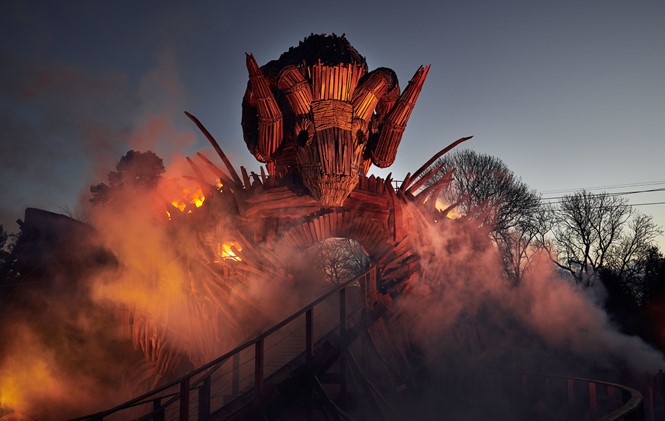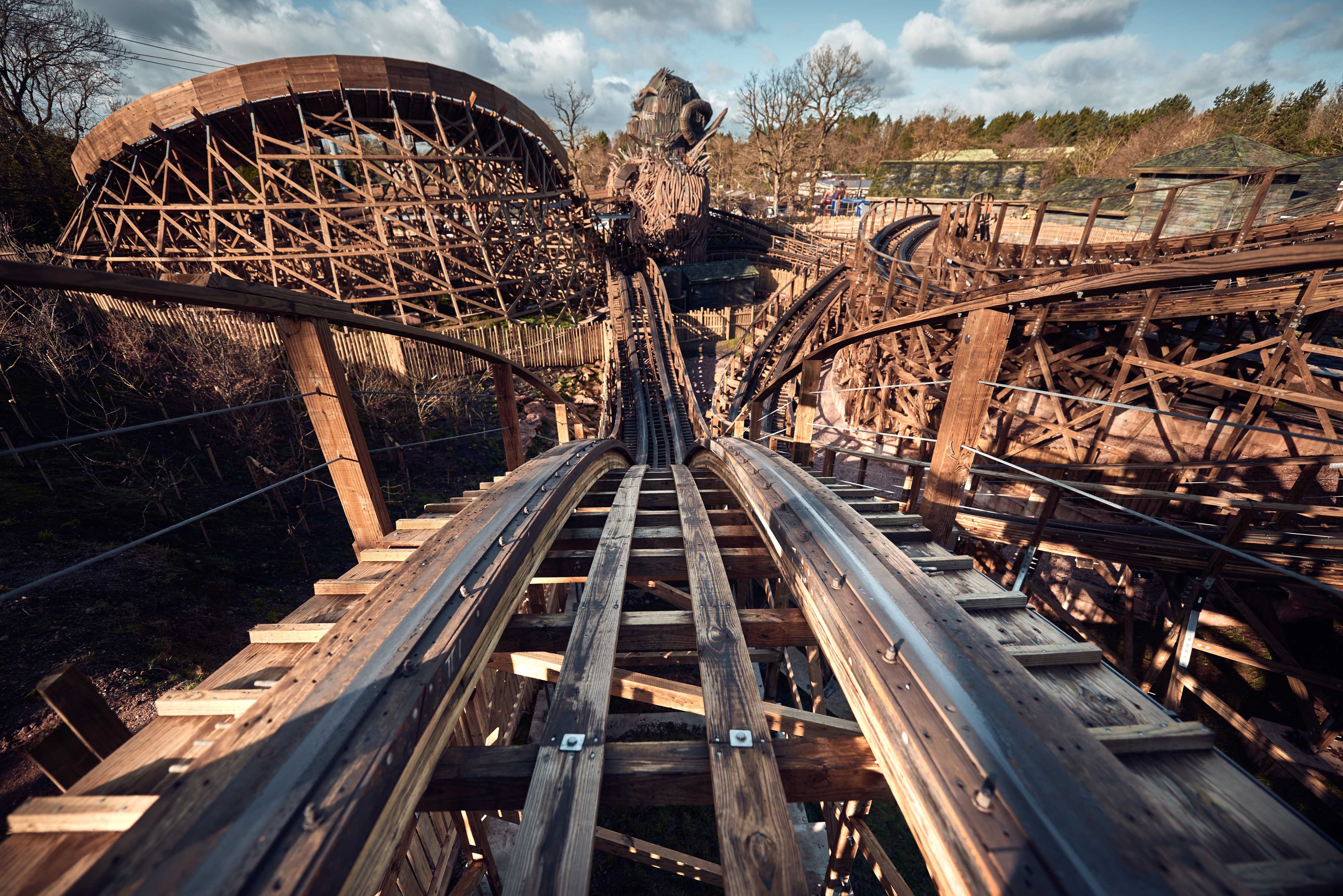Brand profile: Alton Towers

In March, Alton Towers Resort, the UK’s second-most visited theme park, launched the Wicker Man. Given a reputation for groundbreaking experiences, opening the first wooden rollercoaster in the UK for 20 years could be a gamble. But with 100,000 visitors riding in the first month, the project has smashed expectations. Jeremy Owen reports
Alton Towers has enjoyed a long history as a pleasure gardens but it was in the 1980s, with the opening the legendary Corkscrew, one of a handful of double loop rollercoasters in the world at that time, that it put it firmly on the global entertainments map. Over the next 30 years, the momentum was maintained with continued investment in world-class attractions; with such luminaries as The Black Hole, Nemesis, Oblivion and Galactica all transcending their origins to be spoken of in legendary terms by a multigenerational fanbase.
The Wicker Man thus had a lot to live up to from day one of a four-year development programme. Head of PR at Alton Towers, Lizzie Roberts says, “There are a huge range of factors that influence our decision when thinking about a new attraction. The site is certainly one consideration and, in this case, it was the former location of the Log Flume, which had been a much-loved family favourite for 30 years. That had an influence on who the new ride needed to appeal to. We also thought about the suite of coasters we already have. As there has never been a ‘woodie’ here we felt it was something different that would complement our existing coasters. Regular visitors had been campaigning for many years for such a ride but now we had the site available and technology has evolved so we could be certain of delivering something thrilling. It’s a complicated process with many different influences and agendas to balance!”
Essential to the project was the establishment of an elaborate backstory. Never intended to be communicated to visitors, the narrative was constructed as a foundation on which to base all subsequent design and communication decisions. The conceptual springboard was the park’s distinctive location. The site is surrounded by forests and the team leveraged this heavily. Project creative director Bradley Wynn says, “We‘ve literally taken inspiration from Alton village and drawn on local legend to make it feel like part of the Alton environment, to make it ownable by Alton. We put out a number of concepts for market testing. One of them was the most compelling thing we’ve ever market researched – the fusion of wood and fire.” The result was a heady mix of archaeological fact and folk-tale fantasy, the literal kingpin of which being the eponymous Wicker Man, a huge wooden effigy with two faces: one human, one ram. The figure represents a fictional deity of the Beornen, a secretive, feral and equally fictional community that Merlin imagined to be living secreted in the surrounding woods.
As a foundation for a brand identity, the story benefits strongly from the in-built recognition factor that comes from its genesis in historical fact. The worship of similar totems is associated with natural life cycles and can be traced back to ancient pagan and druidic rituals. As a motif, it still appears in many forms across contemporary culture – from characters in computer games like World of Warcraft, to rock music’s Burning Man festival, to, most famously, cinema. The attraction shares both name and theme with an influential British thriller film from 1973 (and a notorious remake from 2006), films that explore the scientifically unproven, but frighteningly captivating suggestion that similar wooden effigies were once used in human sacrifices.
Upon announcement of the ride’s theme much social media commentary focused on the mistaken assumption that the coaster’s theme was based on the film’s narrative, insinuating a link between the film’s subtext and safety concerns around the combination of wood and fire in the light of a serious accident on another of the park’s rides in recent years. Indeed, without these types of concerns, naming and theming an attraction so closely to a famous IP without being a licensed property could seem like an open invitation for critique and negative publicity, but Roberts says, “We thought a lot about the language we used to avoid any links with the darker aspects of the film story. And, for many of our guests, this is their first encounter with the mythology of the Wicker Man so we felt confident that there was little risk of confusion.”
To ensure the ride architecture was as enigmatic as the theming, the creative development teams closely monitored innovations in the theme park industry and across entertainment more broadly, particularly looking at movies and special effects. They visited parks around the world before choosing to work with Great Coasters International, a Pennsylvania-based manufacturer of wooden rollercoasters. The firm delivered a build that combined architecture and practical theming in an experience in which customers become ‘chosen ones’ lured by the secretive tribe to climb aboard a ‘train’ which transports them deep into a covert world via a labyrinthine track which wraps itself around the 18-metre figure as it bursts into flames, ‘immortalising’ the riders and ‘reawakening’ the wooden god to bestow enlightenment and eternal wellbeing on mortals.
Working with such a high, Baroque concept is usually the stock-in-trade of the movie industry. Accordingly, Merlin launched the ride using a marketing model common to major feature films: teaser trailers, press junkets to ‘meet the makers,’ and a celebrity ‘premiere’ for VIPs, influencers and journalists before the ride opened to the public. Merlin has a long-standing relationship with London-based design agency LMC which brought the unique vision to life in a series of key visuals, replete with a specially composed rune alphabet of the Beornen language. These elements were extended into a special edition ‘Roller Poster’ for launch, a piece of artwork heavily influenced by the vernacular of contemporary, supernatural thriller feature films and aimed at attracting sections of the audience that might not otherwise have found out about the ride.


The piece was created by Hollywood visual artist Kyle Lambert, the talent behind the identity of acclaimed Netflix series Stranger Things and other global hits. He says, “My previous works have a dark horror movie quality to them, it also helped being a fan of horror and sci-fi movies. And having grown up in north west England and visiting Alton Towers as a kid, I was very excited to be involved with a project so close to home.”
The outdoor entertainments industry has long led the way in branding experiences in which the customer will actually participate. The travelling showmen of yesteryear had perfected the art of formulating a message of promise to the consumer that they would benefit exponentially from participation in their respective offerings. This was all done with the simple tools of descriptive names and superlatives, writ large. In those early days of flying horse carousels and magic lantern shows and, indeed, right up until the early days of the Corkscrew, the entertainment itself was both the brand and its own reward.
Today, the humble thrill ride operates in a crowded marketplace of diversions, most of which are designed to keep people at home. Of course, many of these can’t compete with actual physical engagement, but the challenge for the Alton Towers brand today is how to get people to come to its particular site in the first place. Over the last 30 years, certain entertainment conglomerates have led the way in creating IP-led properties that can exist across platforms, telling stories that can be enjoyed on home entertainment, played as electronic games and physical toys, consumed as branded food and drink as well as participatory attractions in theme parks.
The problem with this tactic is that often what starts as something meaningful loses its bandwidth, becoming an attractive short-term diversion, but with no power to captivate its audience for the longer term. Conversely, throughout its history Alton Towers has consistently demonstrated how to manufacture experience as both product and promotion in a symbiotic relationship.
With the Wicker Man, Merlin has pushed its own methodology to its zenith, demonstrating that, when it comes to selling experience, of paramount importance will always be the establishment of a cohesive story that should run throughout every element of execution. Moreover, it shows that pure belief, confidence and enjoyment in the delivery of a product instills into an enterprise an authenticity that cannot fail but ring true with customers. Unlike the effigy itself, the brand is not delivering a myth, it is providing what is surely the ultimate consumer product: a lasting, positive memory.












